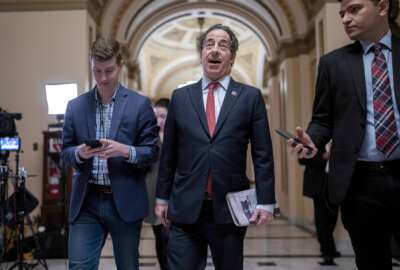Federal telework to remain a crucial issue well into 2025
Already, key Republicans in Congress are looking ahead to further investigations into federal telework options for agency employees.
With an incoming presidential administration and a new Congress both starting up at the beginning of 2025, there are many unknowns about what’s to come for the federal workforce.
But at least one thing is for certain — telework for the federal workforce will remain a high-priority topic for agencies, employees, lawmakers, unions and many others.
Already, key Republicans in Congress are looking ahead to further investigations into telework options for federal employees. House Oversight and Accountability Committee Chairman James Comer (R-Ky.) announced plans to hold a hearing on federal telework once the 119th Congress begins.
The upcoming hearing is expected to address a range of questions on federal telework — but perhaps most notably, lawmakers will look into recent telework agreements between agencies and federal unions. Martin O’Malley, former commissioner of the Social Security Administration, was invited to testify after Republican committee members raised questions about SSA’s recent telework agreement with the American Federation of Government Employees.
“You managed the SSA workforce for only a few days under a collective bargaining agreement that will tie the hands of your successor at SSA for the duration of the next administration, and beyond,” Comer wrote in a Dec. 23 letter to O’Malley. “Your motive for signing such an agreement is unclear.”
AFGE, however, pushed back against the committee leaders’ sentiments.
“We support telework where it delivers for both the taxpayers and the workers who serve them,” AFGE National President Everett Kelley said in a statement. “Telework and remote work are tools that have helped the federal government increase productivity and efficiency, maintain continuity of operations and increase disaster preparedness. These policies also assist agencies across the government, including SSA, in recruiting and retaining top talent.”
Comer said the upcoming hearing with O’Malley will “shed light on why so much of the federal workforce is currently at home, and federal agency offices are largely vacant.”
According to a report from the Office of Management and Budget in August, more than half of federal employees work entirely onsite due to the nature of their jobs. Employees who are eligible for telework are still spending around 60% of their work hours onsite. Just 10% of federal employees work entirely remotely.
The Oversight Committee’s planned hearing is just one example of what’s been a growing trend over the last year when it comes to federal telework. President-elect Donald Trump has also expressed strong aversion to federal telework options. During a December press conference, Trump criticized the new telework agreement between SSA and AFGE and threatened legal action.
On top of that, early plans from Trump’s “Department of Government Efficiency” include rolling back telework for the federal workforce in his second term. Elon Musk and former Republican presidential candidate Vivek Ramaswamy, the leaders of DOGE, have said they would “welcome” resignations of federal employees who don’t want to work onsite full time.
An abundance of federal telework bills
Many lawmakers have also introduced various federal telework bills, all aiming to make changes to the government’s telework program — whether it’s by returning feds to the office, or adding more data and accountability standards. Many of those attempted priorities are likely to make a return in the 119th Congress.
For instance, the Federal Employee Return to Work Act would remove locality pay for any federal employee who teleworks at least one day a week. Federal teleworkers would instead only receive their base pay rates. The bill was referred to the Oversight Committee, but did not see any further action.
Another bill from Sen. Joni Ernst (R-Iowa), called the REMOTE Act, would require agencies to use software to gather data on the adverse impacts of telework in the federal government by monitoring employees’ computer use. The legislation would also require agencies to issue reports and provide key information for individual performance reviews. Congress has not taken action on the bill beyond its introduction.
And within the DOGE Acts from Sen. Marsha Blackburn (R-Tenn.), part of the package aims to rein in federal telework and relocate employees. One of Blackburn’s bills would require agencies to submit a study to Congress on the impacts of expanded federal telework and remote work during the COVID-19 pandemic, as well as agency plans for their future use of telework and remote work.
Over on the House Appropriations Committee, Subcommittee Chairman Robert Aderholt (R-Ala.) also revealed his return-to-office priorities for the federal workforce in June. Earlier versions of House appropriations legislation included new requirements for agencies to publicly report their policies on federal telework and office space. Aderholt’s bill aimed to require agencies to publicly share their office space utilization rates in the D.C. area, as well as the methodology they used to calculate those rates.
One bipartisan bill from April called the Telework Transparency Act aims to provide up-to-date information on federal telework, while also assessing factors like productivity, office space, and recruitment and retention. To assist agencies with the bill’s proposed requirements, the Office of Personnel Management would also have to set clearer data standards and protocols for agencies as they track employees’ participation in telework.
In another view of federal telework, a recent report from the Government Accountability Office found that increased telework helped some agencies recruit and retain employees — although pay and workload still play a bigger role in hiring. The agencies that GAO reviewed for the report — IRS, Farm Service Agency, Veterans Benefits Administration and U.S. Citizenship and Immigration Services — also generally saw improving customer service metrics in recent years while their employees had increased rates of teleworking.
The GAO report also found agencies generally do keep track of how many of their employees telework and how many days they typically work at home versus in the office.
Though the report offers details about just a sample of agencies, GAO said it’s planning to issue a follow-up report describing the use of telework at the Bureau of Indian Affairs and the State Department, as well as SSA — along with a separate report on the use of remote work at agencies.
Copyright © 2025 Federal News Network. All rights reserved. This website is not intended for users located within the European Economic Area.
Drew Friedman is a workforce, pay and benefits reporter for Federal News Network.
Follow @dfriedmanWFED






